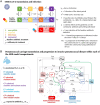Exploring factors shaping antibiotic resistance patterns in Streptococcus pneumoniae during the 2020 COVID-19 pandemic
- PMID: 38451256
- PMCID: PMC10923560
- DOI: 10.7554/eLife.85701
Exploring factors shaping antibiotic resistance patterns in Streptococcus pneumoniae during the 2020 COVID-19 pandemic
Abstract
Non-pharmaceutical interventions implemented to block SARS-CoV-2 transmission in early 2020 led to global reductions in the incidence of invasive pneumococcal disease (IPD). By contrast, most European countries reported an increase in antibiotic resistance among invasive Streptococcus pneumoniae isolates from 2019 to 2020, while an increasing number of studies reported stable pneumococcal carriage prevalence over the same period. To disentangle the impacts of the COVID-19 pandemic on pneumococcal epidemiology in the community setting, we propose a mathematical model formalizing simultaneous transmission of SARS-CoV-2 and antibiotic-sensitive and -resistant strains of S. pneumoniae. To test hypotheses underlying these trends five mechanisms were built into the model and examined: (1) a population-wide reduction of antibiotic prescriptions in the community, (2) lockdown effect on pneumococcal transmission, (3) a reduced risk of developing an IPD due to the absence of common respiratory viruses, (4) community azithromycin use in COVID-19 infected individuals, (5) and a longer carriage duration of antibiotic-resistant pneumococcal strains. Among 31 possible pandemic scenarios involving mechanisms individually or in combination, model simulations surprisingly identified only two scenarios that reproduced the reported trends in the general population. They included factors (1), (3), and (4). These scenarios replicated a nearly 50% reduction in annual IPD, and an increase in antibiotic resistance from 20% to 22%, all while maintaining a relatively stable pneumococcal carriage. Exploring further, higher SARS-CoV-2 R0 values and synergistic within-host virus-bacteria interaction mechanisms could have additionally contributed to the observed antibiotic resistance increase. Our work demonstrates the utility of the mathematical modeling approach in unraveling the complex effects of the COVID-19 pandemic responses on AMR dynamics.
Keywords: COVID-19 pandemic; SARS-CoV-2; Streptococcus pneumoniae; antibiotic resistance; ecology; epidemiology; global health; invasive pneumococcal disease; virus-bacteria interactions.
© 2024, Kovacevic et al.
Conflict of interest statement
AK, DS, ER, SN, PH, EV, LT No competing interests declared, RC received consulting fees from Pfizer, Sanofi, MSD, and GSK, including travel grants from Pfizer and payments from Symposium Pfizer, MSD, GSK, and Sanofi, and participated in advisory/data safety monitoring board at Pfizer, Sanofi, MSD, and GSK, CL received travel grants from Pfizer and payments from Symposium Pfizer and MSD, LO received a research grant from Pfizer and Sanofi Pasteur on unrelated topics through her institution
Figures








Update of
- doi: 10.1101/2022.08.08.503267
Similar articles
-
Increase of Macrolide-Resistance in Streptococcus pneumoniae Strains After the Introduction of the 13-Valent Pneumococcal Conjugate Vaccine in Lima, Peru.Front Cell Infect Microbiol. 2022 May 9;12:866186. doi: 10.3389/fcimb.2022.866186. eCollection 2022. Front Cell Infect Microbiol. 2022. PMID: 35615398 Free PMC article.
-
Decline in Pneumococcal Disease in Young Children During the Coronavirus Disease 2019 (COVID-19) Pandemic in Israel Associated With Suppression of Seasonal Respiratory Viruses, Despite Persistent Pneumococcal Carriage: A Prospective Cohort Study.Clin Infect Dis. 2022 Aug 24;75(1):e1154-e1164. doi: 10.1093/cid/ciab1014. Clin Infect Dis. 2022. PMID: 34904635 Free PMC article.
-
Impact of the Coronavirus Disease 2019 (COVID-19) Pandemic on Invasive Pneumococcal Disease and Risk of Pneumococcal Coinfection With Severe Acute Respiratory Syndrome Coronavirus 2 (SARS-CoV-2): Prospective National Cohort Study, England.Clin Infect Dis. 2021 Mar 1;72(5):e65-e75. doi: 10.1093/cid/ciaa1728. Clin Infect Dis. 2021. PMID: 33196783 Free PMC article.
-
CIRCULATING CLONAL COMPLEXES AND SEQUENCE TYPES OF STREPTOCOCCUS PNEUMONIAE SEROTYPE 19A WORLDWIDE: THE IMPORTANCE OF MULTIDRUG RESISTANCE: A SYSTEMATIC LITERATURE REVIEW.Expert Rev Vaccines. 2021 Jan;20(1):45-57. doi: 10.1080/14760584.2021.1873136. Epub 2021 Feb 17. Expert Rev Vaccines. 2021. PMID: 33507135
-
The impact of the introduction of ten- or thirteen-valent pneumococcal conjugate vaccines on antimicrobial-resistant pneumococcal disease and carriage: A systematic literature review.J Glob Health. 2023 Feb 17;13:05001. doi: 10.7189/jogh.13.05001. J Glob Health. 2023. PMID: 36799235 Free PMC article.
Cited by
-
Global burden of bacterial antimicrobial resistance 1990-2021: a systematic analysis with forecasts to 2050.Lancet. 2024 Sep 28;404(10459):1199-1226. doi: 10.1016/S0140-6736(24)01867-1. Epub 2024 Sep 16. Lancet. 2024. PMID: 39299261 Free PMC article.
-
Antimicrobial Activity of Arthrospira platensis-Mediated Gold Nanoparticles against Streptococcus pneumoniae: A Metabolomic and Docking Study.Int J Mol Sci. 2024 Sep 19;25(18):10090. doi: 10.3390/ijms251810090. Int J Mol Sci. 2024. PMID: 39337576 Free PMC article.
References
-
- Abdullahi O, Karani A, Tigoi CC, Mugo D, Kungu S, Wanjiru E, Jomo J, Musyimi R, Lipsitch M, Scott JAG. Rates of acquisition and clearance of pneumococcal serotypes in the nasopharynges of children in Kilifi District, Kenya. The Journal of Infectious Diseases. 2012;206:1020–1029. doi: 10.1093/infdis/jis447. - DOI - PMC - PubMed
-
- Alpkvist H, Athlin S, Nauclér P, Herrmann B, Abdeldaim G, Slotved HC, Hedlund J, Strålin K. Clinical and microbiological factors associated with high nasopharyngeal pneumococcal density in patients with pneumococcal pneumonia. PLOS ONE. 2015;10:e0140112. doi: 10.1371/journal.pone.0140112. - DOI - PMC - PubMed
-
- Amin-Chowdhury Z, Aiano F, Mensah A, Sheppard CL, Litt D, Fry NK, Andrews N, Ramsay ME, Ladhani SN. impact of the coronavirus disease 2019 (COVID-19) Pandemic on Invasive Pneumococcal Disease and Risk of Pneumococcal Coinfection With Severe Acute Respiratory Syndrome Coronavirus 2 (SARS-CoV-2): Prospective National Cohort Study, England. Clinical Infectious Diseases. 2021;72:e65–e75. doi: 10.1093/cid/ciaa1728. - DOI - PMC - PubMed
MeSH terms
Substances
Grants and funding
LinkOut - more resources
Full Text Sources
Medical
Miscellaneous

